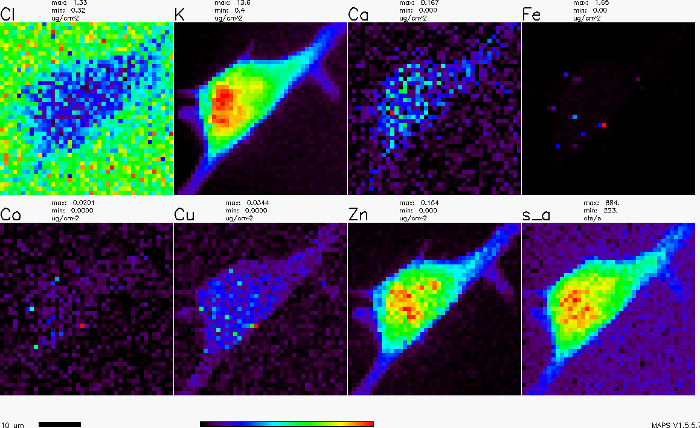엑스레이 형광 (XRF)
Overview
출처: 리디아 피니 박사 연구소 — 아르곤 국립 연구소
X선 형광은 분광 정보를 생성하는 데 사용할 수 있는 유도된 방출 방사선이다. X선 형광 현미경 검사는 금속의 유도된 형광 방출을 사용하여 공간 분포를 식별하고 정량화하는 비파괴 이미징 기술입니다.
Principles
첫째, 샘플은 얇고 평평하며 건조한 샘플을 준비해야 합니다(현미경에 특수 극저온 단계가 제공되지 않는 한). 다음으로, 집중된 단색 X선 빔이 샘플 을 가로질러 래스터 스캔됩니다. X선 빔은 금속 원자에 대한 내부 쉘 전자의 일부 의 결합 에너지를 극복하고 외부 쉘 전자가 그 공석에 빠지면 샘플에 의해 두 번째 X 선이 방출됩니다. 이 래스터 스캔의 모든 지점에서 X 선 형광 방출 스펙트럼은 검출기에 의해 수집됩니다.
이 스펙트럼에서, 샘플에 의해 방출되는 모든 X선의 파장 및 강도가 기록된다. 방출된 형광의 특성 에너지(원자내 궤도의 간격)와 Kα 및 Kβ 피크의 특징적인 상대강도(예를 들어, 둘 다 공지됨)에 기초하여, 방출 스펙트럼은 존재하는 금속의 정체성과 수량을 모두 결정하는 데 사용될 수 있다.
이 비디오는 형광 화상 진찰에 적합한 응신 세포의 얇고 건조한 견본을 준비하는 과정을 설명할 것입니다. 샘플을 스캔하는 과정은 간략하게 설명되고, 예를 설명한 이미지.
Procedure
1. 실리콘 니타드 윈도우 준비
- 역 핀셋을 사용하여 창을 선택합니다 (떨어지면 실리콘 질화물 창이 산산조각 날 것입니다).
- 창을 유리 슬라이드에 놓고 평평한 면을 위로 놓습니다.
- 작은 조각의 스카치 테이프를 창 의 측면에 부착하고 문화 접시의 바닥에 창문을 부착하는 데 사용합니다.
- UV 방사선으로 문화 요리의 창문을 살균하십시오. 이는 UV 크로스링크 캐비닛의 자동 크로스링크 설정과 함께 수행할 수 있으며, 그 다음에는 라미나르 유동 후드의 UV 램프 아래에서 약 1시간 동안 UV 조사를 수행할 수 있습니다.
2. 멸균 실리콘 Nitride 창에 세포를 도금
- 약 45° 각도로 기울어진 접시를 잡습니다.
- 접시의 측면을 향해 파이펫으로 미디어를 추가하고 천천히 미디어로 창을 코팅하는 기울기 각도를 완화합니다.
- 같은 방식으로 배양 접시에 세포를 추가하고 배양합니다.
- 때때로 가벼운 현미경을 사용하여 세포를 관찰하여 언제 사용할 준비가 되었는지 확인합니다.
3. 셀의 고정 및 건조
- 라미나르 플로우 후드에서 위에서 설명한 대로 접시를 기울이면서 부드러운 포부로 미디어를 제거합니다.
- PBS를 추가하여 접시 의 측면을 향해 파이프를 넣고 비스듬히 유지합니다. 천천히 PBS로 창을 코팅하는 기울기 각도를 완화.
- 부드러운 포부로 PBS를 제거하십시오.
- 접시의 측면을 향해 파이프팅하고, 비스듬히 잡고, 세포를 커버하기 위해 4 % PFA / PBS, pH 7을 추가합니다. 실온에서 20 분 동안이 솔루션을 유지하십시오.
- PFA/PBS 혼합물을 제거하고 유해 물질로 폐기하십시오.
- 위에서 설명한 대로 PBS를 추가합니다.
- 3.5 및 3.6 단계를 두 번 반복합니다.
- 부드러운 포부로 PBS를 제거하십시오.
- 20mM 파이프, 200mM 자당, pH 7을 추가합니다.
- 부드러운 포부로 파이프/자당을 제거합니다.
- 2.8 및 2.9 단계를 두 번 반복합니다.
- 김스 와이프와 함께 창의 가장자리와 다시 들여 쓰기를 신속하게 블롯 한 다음 고무 그리드 매트와 같은 깨끗한 표면에 창을 설정하여 건조시합니다.
4. 세포의 엑스레이 형광 화상 진찰
- 샘플이 건조되면 가벼운 현미경을 사용하여 창에 셀의 존재를 확인합니다.
- 매니큐어를 사용하여 빔라인에서 제공하는 알루미늄 홀더에 창문을 고정시하십시오.
- 알루미늄 홀더를 운동마운트에 삽입한 다음 X선 현미경의 광학 초점지점에 배치하고, 약 45°의 각도로 시료 나노위치 단계에 장착된 X선 빔에 배치한다.
- X선 현미경 기기 영역(일반적으로 납 벽으로 만든 오두막)을 종료하고 셔터를 엽니다. 나머지 단계를 원격으로 수행합니다.
- 존 플레이트 또는 Kirkpatrick-Baez 거울을 사용하여 단색 X선 빔(일반적으로 에너지 10keV)을 하위 미크론 스팟 크기로 집중합니다.
- 나노위치 샘플 단계를 사용하고, 미리 보정된 다운스트림 신틸레이터 카메라로 샘플에서 X선 빔의 위치를 보고, 샘플의 데이터를 캡처하기 위해 래스터 스캔의 적절한 폭과 높이를 결정한다.
- 파장 분산 실리콘 드리프트 검출기를 90°에서 사고 빔까지, 시료에서 약 3mm 이하의 파장 분산 실리콘 드리프트 검출기를 사용하여 1-2초의 거주 시간으로 테스트 스펙트럼을 수집합니다.
- 테스트 스펙트럼을 보고, 스캔에 적합한 거주 시간을 선택하고 관심 요소에 충분한 신호-투-노이즈를 제공합니다.
- 샘플의 빔 의 현물 크기보다 현저히 작지 않거나 샘플에 대한 관심 기능보다 크지 않은 스캔에 적합한 해상도를 선택합니다.
- 스캔을 스캔 소프트웨어에 프로그래밍하고 이미지를 수집합니다.
Results
부착 셀의 X선 형광 맵은 도 1에도시된다. 각 패널은 셀 위에 특정 요소(예: 구리, 철, 아연 등)의 분포를 나타낸다. 's_a'라고 표시된 패널은 엑스레이의 흡수를 보여줍니다.

그림 1. 부착 셀의 X 선 형광지도. 이 그림의 더 큰 버전을 보려면 여기를 클릭하십시오.
Application and Summary
엑스레이 형광 화상 진찰은 지구과학, 법의학, 재료 과학, 생물학, 심지어 우리의 문화유산을 공부하는 것을 포함하여 많은 분야에서 유용한 공구가 될 수 있습니다. 재료 과학에서 금속으로 만든 칩과 촉매의 결함을 찾는 데 도움이 될 수 있습니다. 문화유산 작업에서, 그것은 유명한 죽은 사람들의 머리에 유독 한 금속을 식별하는 데 사용되었습니다 (예 : 베토벤), 예술에 사용되는 페인트의 소스를 식별하는 데 사용되었습니다. 생물학에서는 중요한 생화학을 수행하는 천연 금속을 연구하는 데 사용됩니다. 지질 과학에서, 그것은 종종 바위 기록에 기록 된 이벤트를 연구 하는 데 사용 됩니다. X선 형광 이미징을 너무 많은 분야에서 유용하게 만드는 두 가지 특성은 1) 비파괴적, 희귀하거나 높은 값의 많은 항목을 이미지할 수 있으며, 2) 세포에 대해 설명된 샘플 준비는 복잡합니다- 세포는 바위, 예술 또는 기타 품목과 같은 많은 재료에 대해 건조되어야 하기 때문입니다. , 평평하고 먼지가 없어야하는 것 이외에 는 샘플 준비가 거의 필요하지 않습니다. 이러한 시설에서 과학자들과의 협력을 통해 가장 잘 접근할 수 있는 싱크로트론이 필요하지만, 이 기술은 매우 접근할 수 있습니다.
Tags
건너뛰기...
이 컬렉션의 비디오:

Now Playing
엑스레이 형광 (XRF)
Analytical Chemistry
25.8K Views

분석 특성화를 위한 샘플 준비
Analytical Chemistry
85.1K Views

내부 표준
Analytical Chemistry
205.2K Views

표준 추가 방법
Analytical Chemistry
320.5K Views

교정 곡선
Analytical Chemistry
798.2K Views

자외선 눈에 보이는 (UV-Vis) 분광법
Analytical Chemistry
624.7K Views

화학 분석을 위한 라만 분광법
Analytical Chemistry
51.4K Views

화염 이온화 감지를 갖춘 가스 크로마토그래피(GC)
Analytical Chemistry
282.7K Views

고성능 액체 크로마토그래피 (HPLC)
Analytical Chemistry
385.5K Views

이온 교환 크로마토그래피
Analytical Chemistry
264.8K Views

모세관 전기 포레시스 (CE)
Analytical Chemistry
94.2K Views

질량 분광법 소개
Analytical Chemistry
112.6K Views

스캐닝 전자 현미경 검사법 (SEM)
Analytical Chemistry
87.3K Views

전위요스타트/갈바노스타트를 사용하여 지원되는 촉매의 전기화학적 측정
Analytical Chemistry
51.7K Views

순환 볼탐량 (CV)
Analytical Chemistry
125.7K Views
Copyright © 2025 MyJoVE Corporation. 판권 소유